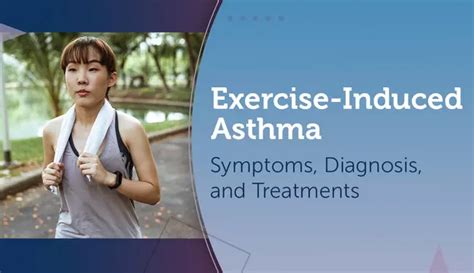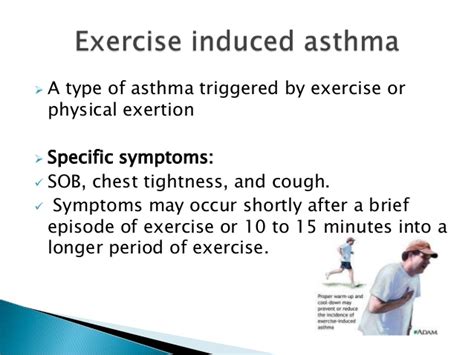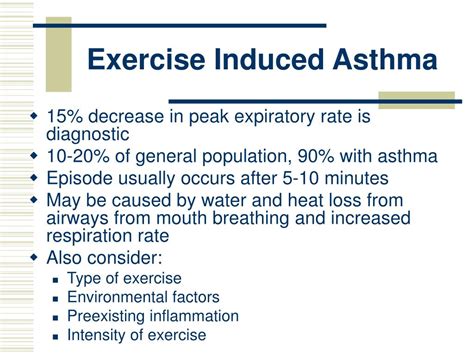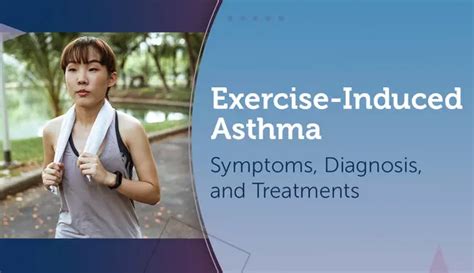Intro
Discover how exercise and physical activity can trigger asthma symptoms, including wheezing and shortness of breath, and learn to manage activity-induced asthma with proper treatment and prevention strategies.
Asthma is a chronic respiratory condition that affects millions of people worldwide, causing symptoms such as wheezing, coughing, and shortness of breath. While asthma can be triggered by a variety of factors, including allergens, air pollution, and respiratory infections, physical activity is a common trigger for many people. Activity-induced asthma symptoms, also known as exercise-induced asthma or exercise-induced bronchospasm, occur when the airways constrict or narrow in response to physical activity, making it difficult to breathe. In this article, we will delve into the world of activity-induced asthma symptoms, exploring the causes, symptoms, diagnosis, treatment, and prevention of this condition.
Asthma is a complex condition, and its relationship with physical activity is multifaceted. On the one hand, regular physical activity is essential for maintaining good physical and mental health, and people with asthma should not be discouraged from exercising. On the other hand, physical activity can trigger asthma symptoms, which can be frightening and debilitating. Understanding the causes of activity-induced asthma symptoms is crucial for developing effective treatment and prevention strategies. One of the primary causes of activity-induced asthma symptoms is the loss of heat and moisture from the airways during exercise. When we exercise, we breathe more rapidly and deeply, which can dry out the airways and trigger inflammation.
Causes of Activity-Induced Asthma Symptoms

Types of Exercise That Trigger Asthma Symptoms
Certain types of exercise are more likely to trigger asthma symptoms than others. These include: * Endurance sports, such as running, cycling, and swimming * High-intensity sports, such as basketball, soccer, and tennis * Sports that involve cold air, such as ice hockey and skiing * Sports that involve pollution, such as running in urban areasSymptoms of Activity-Induced Asthma

Diagnosing Activity-Induced Asthma
Diagnosing activity-induced asthma can be challenging, as the symptoms can be similar to those of other conditions, such as chronic obstructive pulmonary disease (COPD) or heart disease. A diagnosis of activity-induced asthma is typically made based on a combination of medical history, physical examination, and diagnostic tests, such as spirometry or methacholine challenge testing.Treatment and Prevention of Activity-Induced Asthma

Medications for Activity-Induced Asthma
Medications for activity-induced asthma include: * Bronchodilators, such as albuterol or salmeterol * Corticosteroids, such as fluticasone or budesonide * Combination medications, such as fluticasone-salmeterol or budesonide-formoterolManaging Activity-Induced Asthma

Asthma Action Plan
An asthma action plan is a written plan that outlines the steps to take in case of an asthma attack. The plan should include: * A list of medications and dosages * A description of symptoms and when to seek medical attention * A plan for emergency situations, such as an asthma attackLiving with Activity-Induced Asthma

Coping with Activity-Induced Asthma
Coping with activity-induced asthma requires a positive attitude, a supportive network, and a comprehensive treatment plan. People with activity-induced asthma should not be afraid to ask for help or seek support from family, friends, or healthcare providers. Joining a support group or online community can also provide a sense of connection and community.Future Directions

Emerging Therapies
Emerging therapies for activity-induced asthma include: * Biologics, such as omalizumab or mepolizumab * Gene therapy, which involves the use of genes to modify the expression of asthma-related genes * Stem cell therapy, which involves the use of stem cells to repair damaged lung tissueConclusion and Final Thoughts

What is activity-induced asthma?
+Activity-induced asthma, also known as exercise-induced asthma or exercise-induced bronchospasm, is a condition in which physical activity triggers asthma symptoms, such as wheezing, coughing, and shortness of breath.
What are the symptoms of activity-induced asthma?
+The symptoms of activity-induced asthma include wheezing, coughing, shortness of breath, chest tightness, and fatigue.
How is activity-induced asthma diagnosed?
+Activity-induced asthma is diagnosed based on a combination of medical history, physical examination, and diagnostic tests, such as spirometry or methacholine challenge testing.
What are the treatment options for activity-induced asthma?
+Treatment options for activity-induced asthma include medications, such as bronchodilators and corticosteroids, lifestyle changes, and avoidance of triggers.
Can activity-induced asthma be prevented?
+While activity-induced asthma cannot be completely prevented, symptoms can be managed and prevented by avoiding triggers, using medication, and making lifestyle changes.
